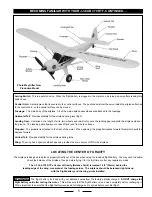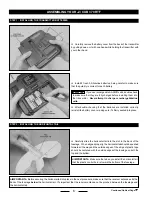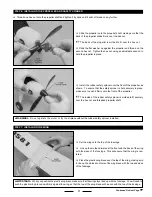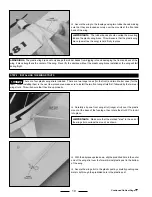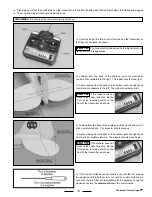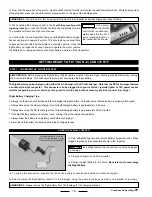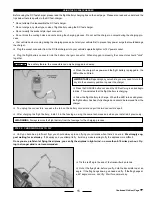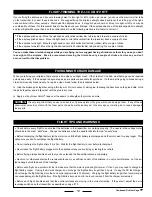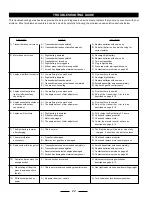
9
If you're flying the airplane and it seems to always want to turn right or left or pitch up or down, you can use the electronic trim tabs
on the transmitter to correct these tendencies. We suggest flying the airplane straight ahead and level, then letting go of the right-
hand control stick for a few seconds. Watch what the airplane does. It may pitch up or down, or it may turn right or left, or it may do
a combination of these. Do this several times to double-check your findings. If the airplane does one of the following while in straight
and level flight without your hand on the control stick, move the following electronic trim tab(s) to correct it:
●
If the airplane pitches up: Move the right-hand control stick vertical trim tab (elevator) forward a couple of clicks.
●
If the airplane pitches down: Move the right-hand control stick vertical trim tab (elevator) back a couple of clicks.
●
If the airplane turns right: Move the right-hand control stick horizontal trim tab (rudder) left a couple of clicks.
●
If the airplane turns left: Move the right-hand control stick horizontal trim tab (rudder) right a couple of clicks.
You can make these trim tab changes while you are flying, but we suggest having a friend move them for you so you don't
lose sight of the airplane. We also recommend moving the trim tabs only a couple of clicks at a time so you don't
over-correct for the trim problem.
FLIGHT-TRIMMING THe J-3 CuB 370 RTF
While you're flying your airplane, there comes a time when you might crash. If the crash isn't too bad, most damage can be repaired
quickly and easily. If the damage is beyond repair, spare parts are available for purchase. If a foam part is going to break during a
crash it will usually break cleanly. To repair a clean break, follow the procedures below:
❑
Glue the broken parts together, using a thin layer of 5 minute epoxy or white glue, following the directions on the glue bottle. Hold
the parts together and in alignment until the glue fully cures.
❑
Apply a strip of clear Scotch
®
tape over the seams to strengthen the joint even more.
It is very important that you use no solvents or Cyanoacrylate (C/A) glue, which can damage foam. If any of these
chemicals comes in contact with the foam parts, the parts will be destroyed. Use only epoxy or white glue to repair damaged
foam parts.
FIXING MINOR CRASH DAMAGe
PRO TIP
●
Check before every flight to ensure that the batteries in the transmitter are working properly. The needle in the voltage meter
should be in the silver "safe" area. Change the batteries when the needle falls into the red "unsafe" area.
●
Before recharging the flight battery, let the motor run until the flight battery is discharged and the motor won't run any longer. This
will ensure you don't overcharge the flight battery.
●
Do not recharge the flight battery if it is hot. Wait for the flight battery to cool before recharging it.
●
Never leave the flight battery plugged into the airplane unless you are flying or testing the controls.
●
Before flying, always double-check that you've extended the transmitter antenna completely.
●
Never cut or otherwise shorten the receiver antenna or you will lose control of the airplane in a very short distance. Let the an-
tenna hang behind the back of the fuselage.
●
Before each flight, do a quick motor test to make sure that the motor is producing full power. If it isn't, you may need to charge the
flight battery longer. If using the AC wall charger, do not charge the flight battery longer than 3 hours. If using the DC fast-charger,
do not charge the flight battery more than one cycle (approximately 30 minutes). Charging the flight battery longer than recommended
can cause damage to the flight battery. If the flight battery becomes hot to the touch, remove it from the charger immediately.
●
Before each flight, double-check that the control surfaces are moving in the correct direction. If they aren't, adjust the servo
reversing switches on the transmitter as described on page # 3.
FLIGHT TIPS AND WARNINGS
Continued On Next Page
☛

